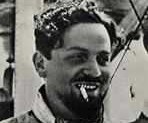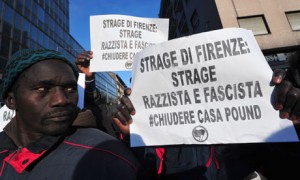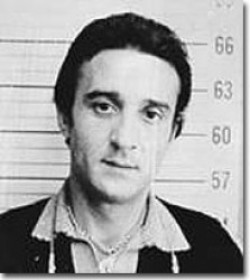Alex Constantine - March 9, 2012
" ... Mussolini was not only admired by the Italian diaspora. Canadian politicians, as well as their British and American counterparts, were glad to have a strong bulwark against the 'Red Menace' in Europe, despite Mussolini’s tyrannical method of rule. ... "
Benito’s benediction
History, politics, and religion, Little Italy style
By Kaj Huddart
 At the corner of Henri-Julien and Dante in Little Italy stands the Church of Madonna della Difesa, one of the most sumptuous and inspiring churches on the island, and a physical testament to the prominence of Montreal’s Italian community. Like many churches in Italy, its ceiling is painted with a colourful fresco. Familiar figures populate the image – Jesus, church officials, angels. But on the right side of the enormous fresco, there appears an unfamiliar man in military dress, sitting straight-backed on a horse. This is Benito Mussolini, notorious Fascist leader, ally of Adolf Hitler, and enemy of Canada in the Second World War. The man who painted him is Guido Nincheri, a celebrated Italian-Canadian artist. But, despite its homage to Mussolini, the Church of Madonna della Difesa has been recognized by the Canadian government as a National Historic Site of Canada.
At the corner of Henri-Julien and Dante in Little Italy stands the Church of Madonna della Difesa, one of the most sumptuous and inspiring churches on the island, and a physical testament to the prominence of Montreal’s Italian community. Like many churches in Italy, its ceiling is painted with a colourful fresco. Familiar figures populate the image – Jesus, church officials, angels. But on the right side of the enormous fresco, there appears an unfamiliar man in military dress, sitting straight-backed on a horse. This is Benito Mussolini, notorious Fascist leader, ally of Adolf Hitler, and enemy of Canada in the Second World War. The man who painted him is Guido Nincheri, a celebrated Italian-Canadian artist. But, despite its homage to Mussolini, the Church of Madonna della Difesa has been recognized by the Canadian government as a National Historic Site of Canada.
The explanation for this curious sight in Little Italy is, as one might expect, intertwined with the story of the artist. However, it also has a great deal to do with 20th century Italian politics, and the history of the Italian immigrant community. The Daily contacted Filippo Salvatore, Italian-Canadian expert and professor at Concordia University, for more information.
Professor Salvatore began by describing the difficult conditions Italians found when they first immigrated to Canada around the turn of the 20th century. Canadian immigration policy favoured Protestant northern Europeans, who were seen as racially and culturally preferable to the Slavs, Jews, and Southern Europeans who were attempting to immigrate to Canada in great numbers. As both southern Europeans and Catholics, Italians were doubly undesirable. Furthermore, many of the Italians who came to Montreal were illiterate manual labourers and factory workers, who had little defence against the Social Darwinist rhetoric of inferiority that relegated them to the lowest rung in the city’s social hierarchy.
As a result of this isolation, Italian labourers found themselves cut off from nearly every higher authority except for the Catholic Church. Attempts were made by the city’s Anglophone elites to “improve” the Italian community by converting them to Protestantism – despite Montreal’s Catholic majority. Indeed, Protestant Italians were not only preferred by local authorities, but also served as the link between the entire community and the Italian government, who had poor relations with the Catholic Church since the appropriation of Papal lands by Giuseppe Garibaldi in the 19th Century. Salvatore noted that, in the early 1900s, the community suffered from poor self-regard due to the dual discrimination based on ethnicity and religion.
However, the arrival of Benito Mussolini in Italian politics drastically changed the way that Italian-Canadians saw themselves. Following World War One and the October Revolution in Russia, revolutionary Communists in Italy threatened to become a powerful force. Mussolini’s virulent anti-Communism, his nationalist rhetoric, and his friendly attitude toward the Catholic Church earned him the title of “Savior of Italy.” He was seen by religious Catholics as a man sent by Providence to restore the nation’s Christian and moral heritage in the face of potential ruin. In his military coup, Mussolini not only removed the possibility of Socialist revolution, he also solved the long-running dispute between the Catholic Church and the Italian Republic by creating the Vatican, thus restoring to the Pope some of his temporal power. Repairing relations with the Church was seen as Mussolini’s great triumph. To Italian Canadians, he inspired admiration, religious gratitude, and, most importantly, pride in being Italian.
But Mussolini was not only admired by the Italian diaspora. Canadian politicians, as well as their British and American counterparts, were glad to have a strong bulwark against the “Red Menace” in Europe, despite Mussolini’s tyrannical method of rule. Indeed, between 1929 and 1936, Mussolini was often spoken of as the most admired leader in Europe. For the Italian-Canadian community, whose leaders were nearly all Fascist supporters, the spectacular rise of Mussolini heralded a merging of Fascism and Italian identity.
The Madonna della Difesa Church was established in 1919 to celebrate the signing of the Lateran Accords that created the Vatican. The community’s most skilled fresco painter, Guido Nincheri, was hired to decorate the interior of the Church. Although Nincheri’s original design included no sign of current politics, the parish priest advised him to insert Mussolini into the image. As a craftsman, Nincheri did as he was told by his employer and priest.
When Adolf Hitler came to power, he expressed his deep admiration for Mussolini and appropriated many Fascist symbols: an alliance between the countries seems to have been inevitable. As the 1930s wore on, Italy and Germany grew closer while the world grew more wary of the increasingly extreme rhetoric espoused by the Nazi Party. In 1938, Mussolini and Hitler signed the “Steel Pact” military alliance. In 1939, war was declared in Europe; and in 1940, Italy declared war on Canada. Overnight, most of Montreal’s Italian community became suspected enemy sympathizers. Male heads of households were rounded up and placed in internment camps to prevent the formation of a fifth column within Canada. Often, Salvatore noted, fathers would be interned while their sons were called up for service in the Armed Forces, a policy that was doomed by its own absurdity. Realistically, there was little chance of Italians forming a fifth column, and the internment of Italian-Canadians was a dark mark in the country’s history. Besides, Salvatore added, the general population held little responsibility for supporting Fascism, as they were led to it by their secular and religious community leaders, some of whom, he suggested, “deserved to be interned”.
 Religious artist Guido Nincheri
Religious artist Guido Nincheri
Along with his fellow community members, Guido Nincheri went to an internment camp. Fortunately, he was able to secure his release by demonstrating his original sketch for the Madonna della Difesa Church, which didn’t incorporate Mussolini. He used this evidence to claim he never had Fascist sympathies. This may have been an exaggeration of the truth, but the internment authorities accepted his plea.
Nincheri then went on to decorate churches throughout Quebec, Canada, and the French-Canadian diaspora areas in New England. His style drew heavily upon the Tuscan region where he was born, a legacy that extends from Giotto to Michelangelo. Nincheri used the same technique as the great fresco painters of the Renaissance, and he saw himself as part of a long line of great artists and craftsmen. Nincheri also admired the British pre-Raphaelite movement of painters such as Dante Gabriel Rossetti, and was highly influenced by that style. In Montreal, his work is found throughout the early to mid-20th century churches. Aside from the Madonna Della Difesa, Nincheri’s greatest works are the ceiling of the Church of St. Leon de Westmount, on Maisonneuve near Clark, and the lavish decorations of the Chateau Dufresne, on Sherbrooke and Pie-IX.
The secularization of Quebec society in the early 1960s – combined with the “Refus Global”, Paul-Emile Borduas’ manifesto on the importance of non-figurative art – signaled an end to the era of construction of lavish religious structures in Montreal. Nincheri’s counterparts in the field retired or found other careers, but he continued to paint religious frescos until his death in 1973. His was the very last generation in a long history of religious painting that had its apogee in the Renaissance works of Michelangelo and others. Montreal is fortunate to have so many existing examples of Guido Nincheri’s art, which stand testament not only to the religious images they convey, but also to the currents of global politics, culture, and immigration that have shaped the history of this city.






